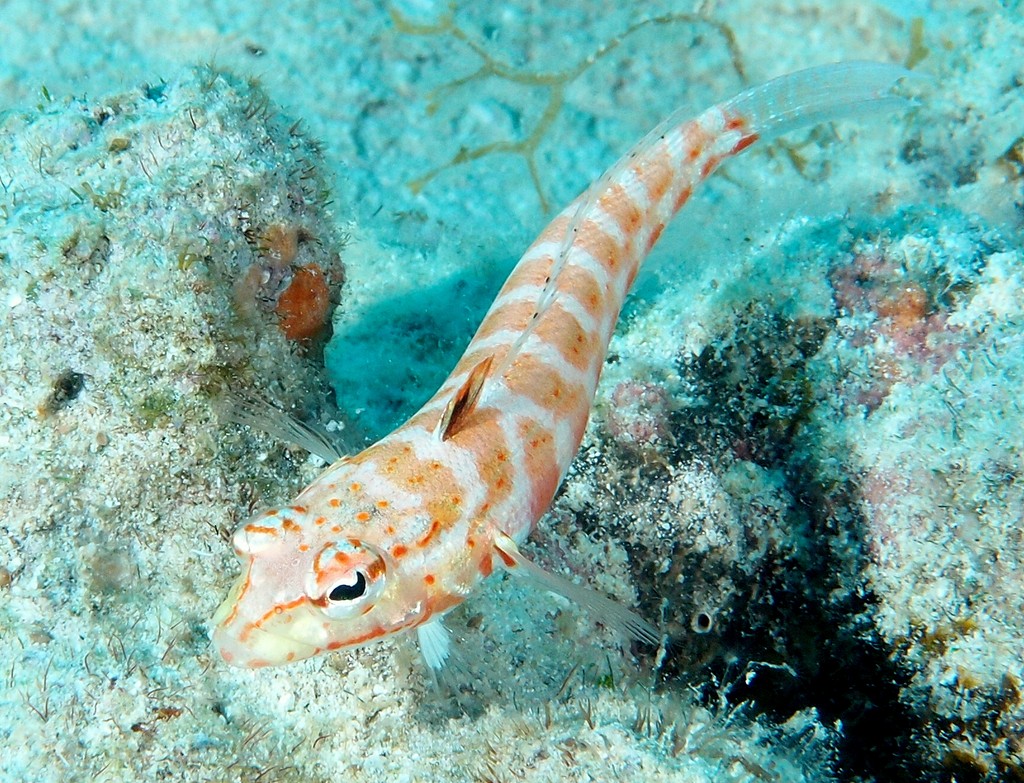PARAPERCIS SCHAUINSLANDII - (STEINDACHNER, 1900)
Actinopterygii (Gigaclass) > Actinopteri (Class) > Teleostei (Subclass) > Labriformes (Order) > Uranoscopoidei (Suborder) > Pinguipedidae (Family) > Parapercis (Genus)
Lyre-tail grubfish, Flagfin weaver, Red-spotted sandperch, Redspotted sandperch, Schauinsland's sea perch, Rosige sandspiering, Rosy sandsmelt, Hawai-toragisu,
Synonymes
Parapercis schauinslandi (Steindachner, 1900)
Percis schauinslandii (Steindachner, 1900)
Description
Dorsal spines (total): 5; Dorsal soft rays (total): 21-22; Anal spines: 1; Anal soft rays: 17-18; Pectoral rays: 16; Lateral line scales: 56-59; Six canine teeth at front of lower jaw; No palatine teeth, Middle dorsal spine longest; Membrane from last dorsal spine joined to firs soft ray near its base; Caudal fin emarginate. Max length: 18.0 cm TL. Depth range: 9 - 170 m.
color
A striking grubfish with eight or nine black or reddish to dark brown blotches on the upper sides, alternating with reddish bars on the lower sides; Spinous dorsal fin black near base, deep reddish distally, soft dorsal fin with a row of dark spots, pectoral-fin base with two narrow bright red bars; Two dark spots on tail base.
Etymology
Parapercis: from Greek prefix, para = resembling to + from Greek, perke = perch. Perch is a common name for fish of the genus Perca, freshwater gamefish belonging to the family Percidae.
schauinslandii: Name give by Franz Steindachner (1834 – 1919) in honnor of Hugo Hermann Schauinsland (1857 - 1937) who was a German zoologist born in Rittergut Dedawe, Kreis Labiau, East Prussia.
Distribution
Indo-Pacific: East Africa to Pitcairn (excluding Easter Island), north to Japan, south to the Great Barrier Reef. Throughout Oceania. Not recorded from the Arabian Peninsula or the southern coast of Asia. Reported from New Caledonia.
Biology
Benthic. Usually on open sand and rubble substrates near reefs. Adults occur on deep seaward and coastal slopes and deep sand flats at depths to 170 m and rises up to about 15 m to feed. Adults have lyre-tail and may swim high above the substrate to feed on zooplankton, usually amongst other fishes such as basslets.
Synonymes
Parapercis schauinslandi (Steindachner, 1900)
Percis schauinslandii (Steindachner, 1900)
Description
Dorsal spines (total): 5; Dorsal soft rays (total): 21-22; Anal spines: 1; Anal soft rays: 17-18; Pectoral rays: 16; Lateral line scales: 56-59; Six canine teeth at front of lower jaw; No palatine teeth, Middle dorsal spine longest; Membrane from last dorsal spine joined to firs soft ray near its base; Caudal fin emarginate. Max length: 18.0 cm TL. Depth range: 9 - 170 m.
color
A striking grubfish with eight or nine black or reddish to dark brown blotches on the upper sides, alternating with reddish bars on the lower sides; Spinous dorsal fin black near base, deep reddish distally, soft dorsal fin with a row of dark spots, pectoral-fin base with two narrow bright red bars; Two dark spots on tail base.
Etymology
Parapercis: from Greek prefix, para = resembling to + from Greek, perke = perch. Perch is a common name for fish of the genus Perca, freshwater gamefish belonging to the family Percidae.
schauinslandii: Name give by Franz Steindachner (1834 – 1919) in honnor of Hugo Hermann Schauinsland (1857 - 1937) who was a German zoologist born in Rittergut Dedawe, Kreis Labiau, East Prussia.
Distribution
Indo-Pacific: East Africa to Pitcairn (excluding Easter Island), north to Japan, south to the Great Barrier Reef. Throughout Oceania. Not recorded from the Arabian Peninsula or the southern coast of Asia. Reported from New Caledonia.
Biology
Benthic. Usually on open sand and rubble substrates near reefs. Adults occur on deep seaward and coastal slopes and deep sand flats at depths to 170 m and rises up to about 15 m to feed. Adults have lyre-tail and may swim high above the substrate to feed on zooplankton, usually amongst other fishes such as basslets.
